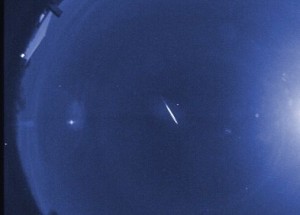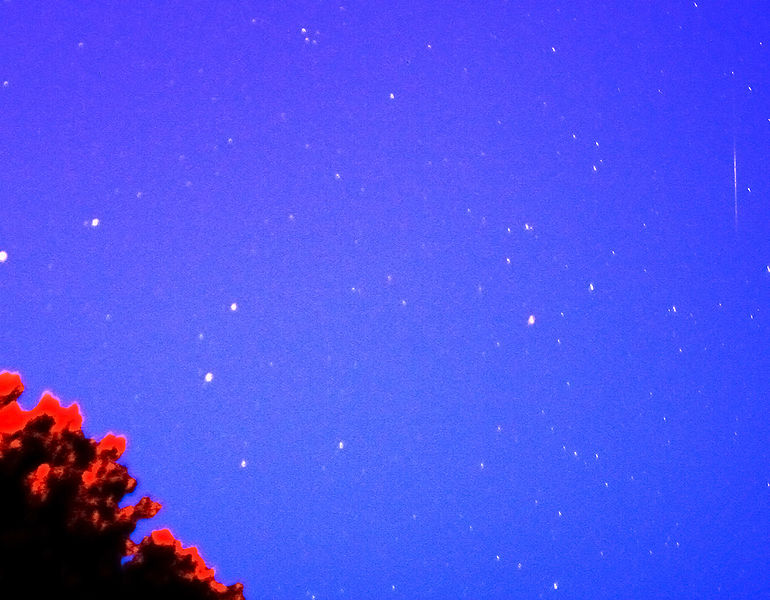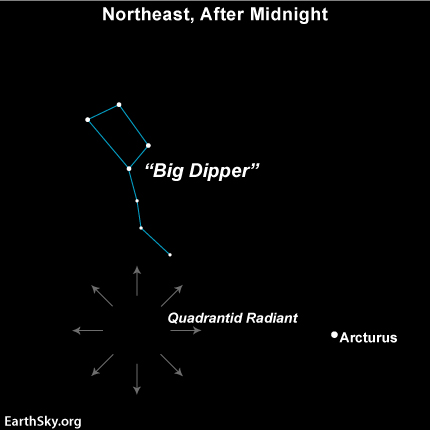
Quadrantid meteor 2010 via NASA/MSFC/MEO/B. Cooke
|
|
The annual Quadrantid meteor shower will peak on the morning of January 3, 2013. It is themorning of January 3, not that evening. This shower has a notoriously narrow peak, lasting only a few hours. This year the waning gibbous moon will be in the sky during the best hours for meteor-watching, but some of the meteors will be bright. You might see some, skimming along in bright moonlight, if you look.

This Quadrantid meteor, seen in 2009, was bright enough to be seen in twilight. The meteor is the streak on the right side of the image. Image by Mila Zinkova.

False-color image of a rare early Quadrantid, captured by a NASA meteor camera in 2010. Image Credit: NASA/MSFC/MEO/B. Cooke

The radiant point for the Quadrantid meteor shower is near the Big Dipper and bright star Arcturus in the constellation Bootes. The radiant is far to the north in our sky, in other words. That’s why this shower is best for Northern Hemisphere observers.
Unlike some meteor showers, whose peak can last a day or two, and whose meteors can fly in lesser numbers for weeks, the Quadrantids’ peak is very narrow, lasting only a few hours. So you have to be in the right place on Earth’s globe to observe the meteor shower’s peak, but, if you are, you might see 100 or even 200 Quadrantid meteors in an hour. Woot?! Yes, in some years. But the moon is in the way for the Quadrantids this year, no matter where you are on Earth.
Most meteor showers are named for the constellations from which they appear to radiate. So it is with the Quadrantids. But the Quadrantids’ constellation no longer exists. The name Quadrantids comes from the constellation Quadrans Muralis (mural quadrant), created by the French astronomer Jerome Lalande in 1795, and representing an early astronomical instrument used to observe and plot stars. This constellation was located between the constellations of Bootes the Herdsman and Draco the Dragon. Where did it go? When the International Astronomical Union made its list of 88 “official” constellations in the 1930s, Quadrans Muralis did not make the list. The meteor shower was first seen in 1825, though, and still retains the name of this now-extinct constellation.
Today the radiant point for the Quadrantids is at the northern tip of Bootes, near the Big Dipper asterism in our sky, not far from Bootes’ brightest star Arcturus. It is very far north on the sky’s dome, which is why Southern Hemisphere observers probably won’t see many (if any) Quadrantid meteors. The meteors simply won’t make it above the horizon for Southern Hemisphere skywatchers.

In 2003, Peter Jenniskens proposed that this object, 2003 EH1, is the parent body of the Quadrantid meteor shower.
In 2003, astronomer Peter Jenniskens tentatively identified the parent body of the Quadrantids as the asteroid 2003 EH1. If indeed this body is the Quadrantids parent, then the Quadrantids, like the Geminid meteors, come from a rocky body – not an icy comet. In turn, though, 2003 EH1 might be the same object as the comet C/1490 Y1, which was observed by Chinese, Japanese and Korean astronomers 500 years ago. Our nomenclature for these space bodies – asteroid, comet – are just words, after all. They’re a net of language thrown over Nature, which operates by its own subtle rules.
Whatever their origin, the bits of asteroidal or cometary debris that become Quadrantid meteors enter our atmosphere at 250 miles per second! They typically vaporize about 50 miles above Earth’s surface, creating the streaks of light we see as a meteor shower. If you’re in the Northern Hemisphere on the morning on January 3, 2013, check out the Quadrantid meteors. Try watching from midnight until dawn, and remember … the moon is in the way.
No comments:
Post a Comment